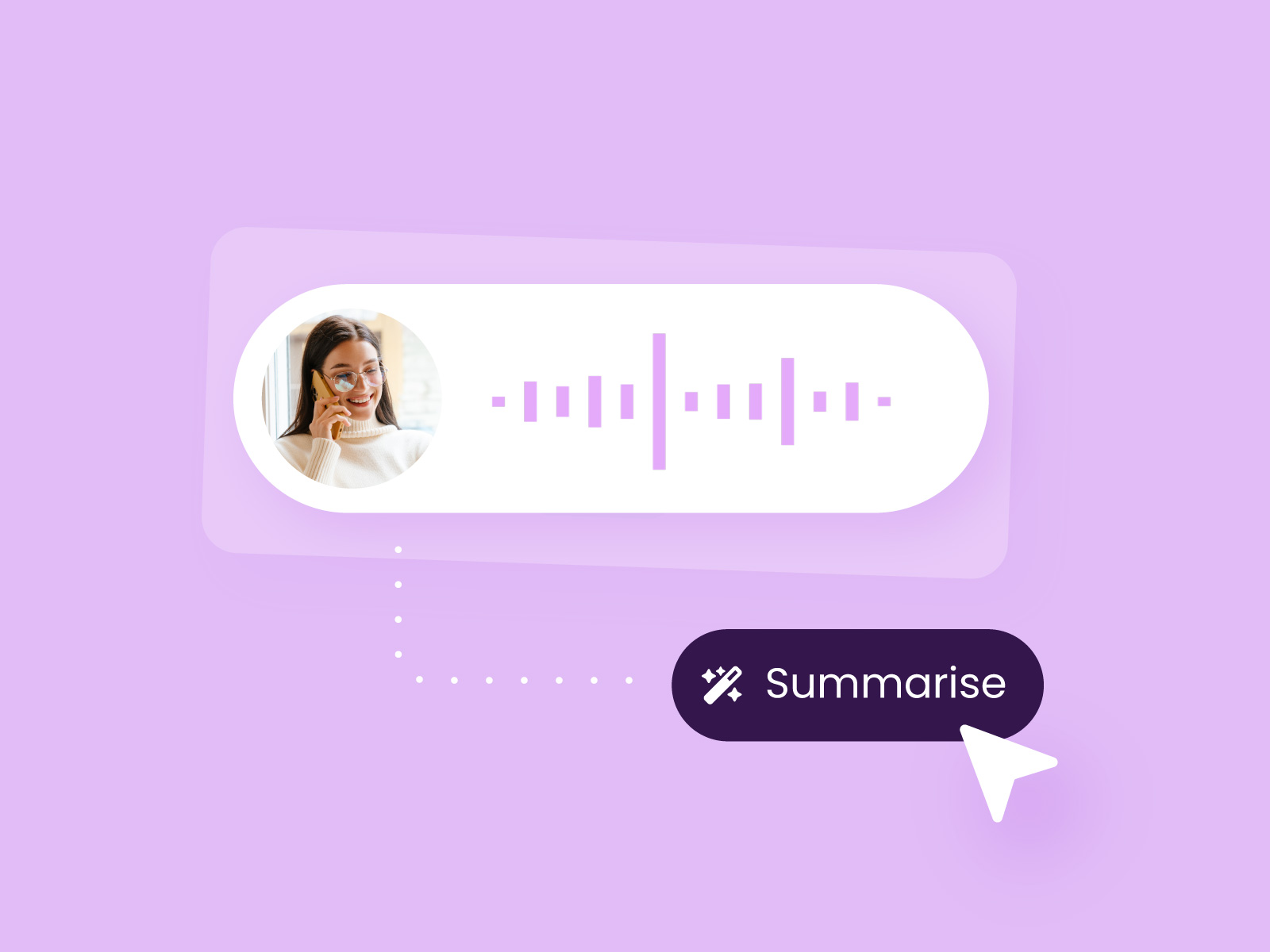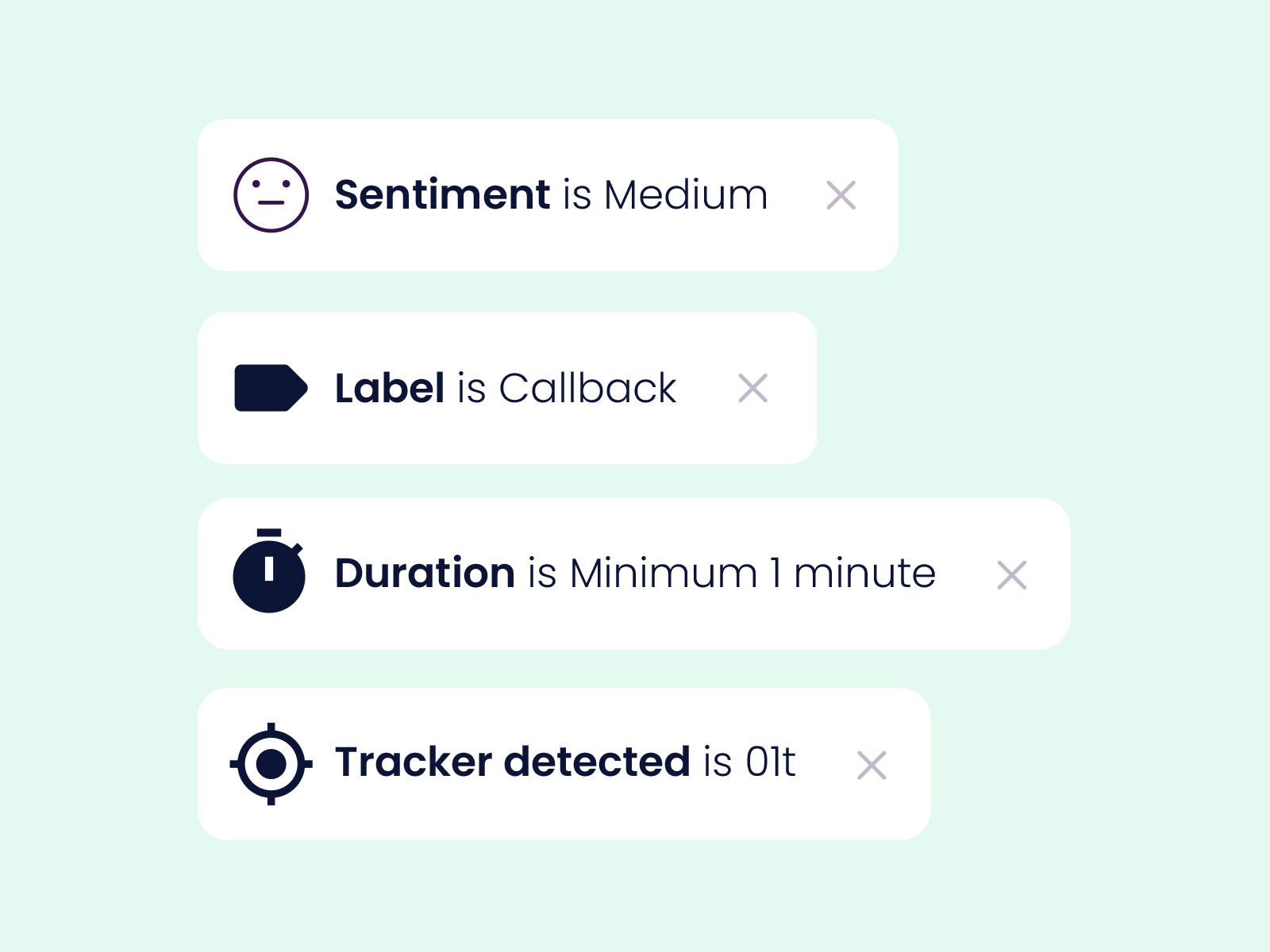Last updated: November 2025
It’s safe to say that Artificial Intelligence (AI) has been on everyone’s lips in the last couple of years, capturing the attention of business leaders and consumers alike. Tools like AI chatbots, for example, have existed for years but gained massive popularity with the introduction of ChatGPT in November 2022.
For customer service teams, AI can bring significant advantages—improving efficiency, speeding up resolution times, and transforming the overall experience. Here are some statistics that highlight the impact of AI:
- 64% of businesses expect AI to boost productivity, according to Forbes.
- 84% of business leaders are currently using AI to engage with customers, according to Liveperson.
- 69% of organisations believe generative AI can help humanise digital interactions, according to Zendesk.
- 75% of respondents say that AI and automation tools will help improve customer service response time, according to Hubspot.
- Over 90% of organisations using AI report time and cost savings, according to Salesforce.
Overall, AI can bring many possibilities to CX organisations. But navigating the different terms and definitions of AI can be tricky. Here, we’ve put together this AI glossary to guide you through essential AI terminology, helping you understand everything from AI chatbots to natural language processing (NLP).
Glossary of AI terms for customer service
A | B | C | D | E | F | G | H | I | J | K | L | M | N | O | P | Q | R | S | T | U | V | W
A.
Agent Assist
Agent assist refers to AI tools that support human agents during customer interactions by providing real-time information, recommendations, and resources. In customer service, agent assist solutions help agents resolve customer issues more efficiently, leading to faster response times and improved customer satisfaction.
Agentic AI
Agentic AI refers to a new type of artificial intelligence that can act autonomously to achieve goals without waiting for instructions. Unlike traditional or generative AI, which reacts to prompts, agentic AI takes initiative - analysing data, making decisions, and carrying out tasks on its own.
AI (Artificial Intelligence)
Artificial Intelligence (AI) refers to the simulation of human intelligence in machines. These systems are designed to think and learn like humans, handling tasks such as understanding language, recognising patterns, and making decisions. Artificial Intelligence in customer service is growing in popularity. From AI chatbots to virtual assistants, AI is transforming customer service by automating tasks, improving user experiences, and speeding up responses.
AI agent
An AI agent is a software program or system that uses artificial intelligence to perform tasks autonomously. Commonly powered by technologies like machine learning, natural language processing (NLP), and automation, AI agents can handle a wide range of functions, from answering queries and processing data to providing personalised recommendations. In customer service, AI agents can manage routine inquiries, resolve common issues, and guide customers through self-service options, all while providing quick and accurate responses.
AI chatbot
An AI chatbot uses artificial intelligence, machine learning (ML), and natural language processing (NLP) to engage in human-like conversations with users, providing dynamic responses based on context and user intent. Unlike rule-based chatbots, AI chatbots can understand context and user intent, providing more dynamic and personalised responses. They’re a go-to tool for improving customer service efficiency. Learn more about AI chatbots here.
AI prompt engineers
AI prompt engineers specialise in designing, refining, and testing prompts—specific phrases or instructions—to guide AI language models in producing accurate, relevant, and reliable responses. In customer service, prompt engineers work to optimise AI-driven chatbots or virtual assistants, ensuring they deliver precise information, maintain the brand’s tone, and effectively address customer needs. This role requires a blend of language skills, technical understanding, and strategic thinking to craft prompts that align with user intent and enhance the overall AI performance, improving customer experience and efficiency.
AI safety
AI safety focuses on ensuring that AI systems operate as intended and do not cause harm. In the context of customer service, AI safety involves creating safeguards to prevent AI chatbots from generating inappropriate, biased, or harmful responses, ensuring a reliable and secure customer experience.
AI safeguards
AI safeguards are measures implemented to ensure that artificial intelligence systems operate safely and ethically. These may include privacy protection, bias detection, and secure data handling practices. In customer service, AI safeguards help prevent harmful outcomes, such as misinformation or breaches of customer data, ensuring a trustworthy interaction between AI and customers.
Algorithm
An algorithm is a series of instructions a machine follows to complete a task – in other words - a set of rules or calculations used by computers to perform tasks or solve problems. In AI, algorithms are essential for processing data, learning patterns, and making decisions. Machine learning algorithms can learn from data over time, enabling more intelligent and relevant customer service. For example, AI on platforms like TikTok uses algorithms to recommend content based on your behaviour and preferences.
Alignment
Alignment in AI refers to the process of ensuring that an AI system's goals and actions are in line with human values and intentions. In customer service, ensuring AI alignment is critical to avoid AI making decisions or providing responses that contradict company policies or harm the customer experience.
Automated response
An automated response is a pre-set message sent by a chatbot or system in response to user queries, often used for common questions or tasks.
Artificial General Intelligence (AGI)
Artificial General Intelligence (AGI) is a theoretical form of AI that possesses the ability to understand, learn, and apply knowledge across a wide range of tasks at a level comparable to human intelligence. In other words, AGI is the theory that AI systems will eventually perform any task that humans can. While AGI is still theoretical, it's a key topic in discussions about the future of AI and its impact on jobs and industries. Tip! Read what the former GTM leader at OpenAI thinks about AGI here.
Artificial Narrow Intelligence (ANI)
ANI refers to AI systems that are designed for a narrow set of tasks, such as responding to customer queries or recommending products. These systems are highly specialised but lack the broader cognitive abilities associated with general intelligence. Most customer service AI today is ANI-based.
Bard (Gemini)
Developed by Google, Bard (now called Gemini) is a conversational AI that engages users in natural language dialogues. Powered by generative AI, it delivers relevant answers and information based on user inputs. Google rebranded Bard to Gemini as part of its evolution into a more advanced AI model.
BERT (Bidirectional Encoder Representations from Transformers)
BERT is a transformer-based machine learning model developed by Google that is designed for natural language processing (NLP) tasks. By understanding context in both directions, BERT enhances AI’s ability to comprehend and generate human-like responses. In customer service, BERT improves chatbot capabilities by enabling more accurate understanding of customer queries and intents.
Big Data
Large and complex data sets that traditional data processing software cannot manage. In customer service, big data can be analysed to gain insights into customer preferences and behaviours.
Bing Chat (Microsoft Copilot)
Bing Chat, now known as Microsoft Copilot, is Microsoft’s AI-powered chatbot integrated into its Bing search engine. It allows users to have natural language conversations and offers answers directly within search results.
Boosting
Boosting is an ensemble machine learning technique used to improve the accuracy of models by combining multiple weak models to create a stronger, more accurate prediction. In customer service, boosting can help AI systems make better predictions, such as routing queries to the correct agent or department.
Bot
A bot is a software application that automates tasks or simulates conversations with users. In customer service, bots are often used to handle repetitive queries, assist customers with troubleshooting, or provide information instantly without human intervention.
Bot trainer
A bot trainer is a professional who works to improve the performance of AI bots by training them on how to respond to different types of queries and situations. This includes feeding the bot new data, adjusting responses, and fine-tuning algorithms to improve the quality of interactions in customer service environments.
Chatbot
A chatbot is a software application designed to conduct conversations with users via text or voice, often integrated into websites or messaging platforms. Typically, chatbots are categorised into rule-based and AI chatbots. Learn more about chatbot in our in-depth guide here.
ChatGPT
ChatGPT is an AI chatbot developed by OpenAI that uses the GPT (Generative Pre-trained Transformer) model to generate human-like text responses, widely used for a variety of conversational applications. It’s known for its conversational fluency and has become widely popular since its launch in November 2022, reaching 100 million users in just two months.
Chat summary
Chat summary refers to AI-generated brief overviews of customer service interactions, typically after a chatbot or human agent has concluded a conversation. These summaries help customer service teams review interactions quickly, ensuring key points and issues are captured for follow-up or analysis.
Classification AI
Classification AI is designed to categorise data into specific groups or classes based on predefined criteria. In customer service, classification AI helps route queries to the right departments or agents by identifying the nature of the query.
Clustering
Clustering is a machine learning technique used to group similar data points together. In customer service, clustering can help AI identify patterns in customer behaviour, segmenting customers based on their queries, preferences, or interaction history to provide more personalised service.
Cognitive Computing
Cognitive computing refers to AI systems that simulate human thought processes, allowing them to reason, learn, and interact more naturally. In customer service, cognitive computing powers virtual assistants and chatbots, enabling them to provide intelligent, context-aware responses and recommendations.
Copilot
An AI co-pilot (also written copilot) is an intelligent assistant designed to support humans in real time by offering suggestions, automating routine tasks, and providing relevant information when needed.
Confidence interval
A confidence interval is a statistical range that indicates the degree of certainty around a prediction or estimate. In AI, confidence intervals help determine the reliability of a model’s predictions, particularly in customer service, where AI chatbots or analytics tools make decisions based on historical data.
Conversational AI
Conversational AI allows machines to engage in human-like conversations by combining natural language processing, machine learning, and AI. It powers chatbots and virtual assistants, making customer interactions more seamless, enhancing the customer experience by making interactions feel more natural and efficient.
Conversational analytics
Conversational analytics is the process of analysing text or speech data from customer interactions to gain insights into customer sentiment, preferences, and behaviour. In customer service, conversational analytics can help improve chatbot responses, identify trends, and enhance customer experience by understanding what customers are saying.
CRM (Customer Relationship Management)
CRM refers to tools and systems used to manage a company's interactions with current and potential customers. AI integration with CRM systems can automate tasks, track customer behaviour, and improve personalised customer service.
Customer Experience (CX)
Customer experience is the overall impression and interaction a customer has with a brand throughout their journey, encompassing all touchpoints and experiences. AI plays a crucial role in enhancing CX by offering faster, more personalised support, and improving customer satisfaction. Learn more about customer experience in this extensive guide.
Customer sentiment
Customer sentiment refers to the emotions and opinions expressed by customers in their interactions with a brand or service. In customer service, analysing customer sentiment helps businesses understand how customers feel about their products and services, enabling them to tailor responses and improve overall customer experience.
Customer service
Customer service refers to the support and assistance provided by a company to its customers before, during, and after a purchase or interaction. It encompasses addressing customer inquiries, resolving issues, and ensuring satisfaction. In today's landscape, customer service is increasingly enhanced by AI technologies, such as chatbots and automation, which help deliver faster and more personalised responses, ultimately improving the overall customer experience.
Customer support automation
Customer support automation involves using AI, including AI chatbots, to automate repetitive tasks like answering FAQs, helping with troubleshooting, and improving response times. This automation allows businesses to focus more on complex customer issues, improving efficiency.
DALL-E
Developed by OpenAI, DALL-E is a cutting-edge AI that creates images from text descriptions. Its recent upgrade, DALL-E 3, significantly improves the accuracy of its visual creations, allowing users to generate images that closely match the input text.
Data privacy
Data privacy refers to how personal information is handled and protected. When using AI, especially in customer service, it’s crucial to ensure that customer data is kept confidential and secure, adhering to regulations like GDPR and CCPA.
Data security
Data security focuses on protecting digital information from unauthorised access or corruption. With AI, safeguarding sensitive customer data is a top priority, requiring robust encryption and security measures.
Deep learning
Deep learning is a more complex form of machine learning that uses neural networks to mimic human brain functions. Deep learning is often used in AI chatbots to improve natural language understanding and conversation flow.
Emailbot
An emailbot is an AI-powered tool designed to automate responses to customer emails, streamlining communication and improving response times. Emailbots can handle various customer service tasks, from providing quick answers to common inquiries to routing more complex questions to human agents. They use natural language processing (NLP) to understand customer messages and deliver accurate, relevant replies.
Emotive AI
Emotive AI is designed to recognise and respond to human emotions, enhancing interactions by tailoring responses based on the emotional state of the user.
F.
Foundation model
A foundation model refers to a large-scale AI model that is trained on vast amounts of data and can be fine-tuned for a wide range of tasks. These models, such as GPT or BERT, form the basis for more specific AI applications, including chatbots and other customer service tools, enabling flexible and scalable AI solutions.
G.
GDPR (General Data Protection Regulation)
GDPR is a European Union regulation designed to protect individuals' privacy and personal data. AI systems in customer service must comply with GDPR, ensuring that customer information is handled securely, and that customers' rights regarding their data are respected.
Gemini
Previously known as Bard, Gemini is Google’s next-generation AI chatbot that uses advanced generative AI models to improve conversational interactions with users.
Generative AI (GenAI)
Generative AI, also known as GenAI, is a form of artificial intelligence that creates new content—text, images, or even music—based on input data and prompts. In customer service, generative AI chatbots can craft unique responses that feel more natural and conversational.
Generative Pre-trained Transformer (GPT)
GPT is an AI architecture developed by OpenAI, which powers several advanced AI applications like ChatGPT. It uses deep learning to generate human-like text, making it one of the most sophisticated tools in conversational AI.
Hallucination
In AI, hallucination refers to instances where an AI model, for example an AI chatbot, generates responses that sound plausible but are factually incorrect or nonsensical. It's when an AI model shares information that is false or misleading but presents it as if it were accurate. For example, an AI chatbot might answer very confidently to a response that is in fact incorrect.
Human-in-the-Loop (HITL)
A hybrid approach where humans assist AI systems in completing tasks, ensuring higher accuracy. This is especially useful in customer service when AI may struggle with more complex inquiries.
I.
Intelligent routing
AI-powered intelligent routing directs customer inquiries to the most appropriate agent or resource based on the complexity of the query, the customer's history, or the nature of the issue. It helps optimise response times and agent efficiency.
Intents
In AI, an intent is the goal or purpose behind a user's input. Understanding user intent is crucial for chatbots to provide accurate and relevant responses, improving the overall customer experience.
Integrations
The process of connecting different software systems or applications to work together. In customer service, integrations can enhance chatbot functionality and streamline workflows.
J.
Jailbreaking
Jailbreaking in AI refers to bypassing the restrictions or safety protocols set by the creators of an AI model, allowing it to perform tasks or respond in ways not originally intended. In the context of customer service, jailbreaking an AI chatbot can expose vulnerabilities, making it less reliable or even harmful.
K.
Knowledge base
A knowledge base is a repository of information that AI systems can access to provide accurate responses. In customer service, chatbots often rely on a knowledge base to answer frequently asked questions.
Large Language Models (LLMs)
LLMs are AI models, like GPT, that process and generate human-like text by understanding and predicting language patterns. They are a core technology behind many AI chatbots used in customer service today.
Live chat
A real-time chat service that allows customers to interact with human agents through a website or application, often used alongside chatbots.
Machine Learning (ML)
Machine Learning is a subset of AI that focuses on the development of algorithms that allow machines to learn from and make predictions based on data. In customer service, ML helps chatbots improve their responses over time.
Microsoft Copilot
Formerly known as Bing Chat, Microsoft Copilot is an AI assistant that leverages GPT-4 to provide conversational AI assistance across Microsoft products, helping users with everything from web searches to task management.
Midjourney
Midjourney is an AI platform that generates images from textual descriptions, similar to DALL-E. It allows businesses to create visuals based on user input, providing a powerful tool for marketing, content creation, and customer service visuals. In customer interactions, image-generation AI can help brands create more engaging visual content on demand.
Multilingual AI
Multilingual AI refers to AI systems capable of understanding and processing multiple languages. In customer service, multilingual AI enables chatbots and virtual assistants to communicate with customers across different languages, offering global support and improving customer experiences.
Natural Language Generation (NLG)
Natural Language Generation (NLG) is the AI process that converts data into human-readable text. This is what allows AI systems, like chatbots, to generate coherent and contextually relevant responses in customer service interactions.
Natural Language Processing (NLP)
Natural Language Processing (NLP) is the technology that allows AI to understand and process human language. It’s the key component behind any conversational AI, enabling chatbots to interpret customer queries and provide appropriate responses.
Natural Language Understanding (NLU)
A branch of NLP, NLU enables AI systems to grasp the meaning behind user inputs. It’s essential for chatbots to understand context, intent, and nuances in customer interactions.
Neural network
A neural network is a computing system inspired by the human brain, consisting of interconnected nodes (neurons) that process information in layers. These networks are essential for deep learning applications in AI, allowing chatbots and other AI systems to recognise patterns, improve decision-making, and engage in more human-like conversations.
O.
Omnichannel support
A customer service approach that provides a seamless experience across multiple channels, such as email, social media, chat, and phone, allowing customers to switch between channels without losing context.
OpenAI
OpenAI is an AI research organisation founded in 2015. They gained significant recognition for pioneering advancements in generative AI technologies, particularly with the development of the GPT (Generative Pre-trained Transformer) family of large language models (LLMs). Their best-known products include ChatGPT and DALL-E.
Open-source
Open-source refers to software whose source code is made available to the public for use, modification, and distribution. In AI, open-source models allow businesses to customise and refine AI tools to better suit their needs, often leading to more flexible and tailored customer service solutions.
Personalisation
Personalisation tailors customer experiences based on individual preferences, history, and behaviour. AI can analyse data to provide highly personalised interactions, improving customer satisfaction and engagement.
Pre-trained Model
A pre-trained model is an AI model that has been trained on a large dataset and can be fine-tuned for specific tasks. For customer service, using pre-trained models allows businesses to deploy AI solutions like chatbots more quickly, reducing the time and resources needed to train the model from scratch.
Predictive analytics
Predictive analytics involves using historical data and AI to forecast future outcomes. In customer service, predictive analytics can help anticipate customer needs, identify potential issues, and personalise support, improving overall efficiency and satisfaction.
Prompt
A prompt is an input or question given to an AI system to generate a response. Well-crafted prompts help AI models like ChatGPT deliver more accurate and relevant answers.
Prompt engineering
Prompt engineering involves designing inputs or "prompts" to effectively guide AI models, like ChatGPT, in generating the desired outputs. It’s a crucial skill for optimising AI responses, ensuring that chatbots or virtual assistants provide accurate, relevant, and human-like answers based on customer queries.
R.
RPA (Robotic Process Automation)
Robotic Process Automation (RPA) is a technology that automates repetitive tasks through the use of software robots. In customer service, RPA can handle tasks such as data entry, processing requests, and managing workflows, allowing human agents to focus on more complex customer interactions and enhancing operational efficiency.
Rule-based chatbots
These chatbots follow a predefined set of rules and responses, making them less flexible than AI chatbots. They’re typically used for handling simple queries where the conversation follows a set path.
Responsible AI
Responsible AI refers to the practice of developing and deploying AI systems in ways that are ethical, transparent, and fair. In customer service, responsible AI ensures that chatbots and other AI tools adhere to privacy, security, and fairness guidelines, promoting trust and positive user experiences.
S.
Search AI
Search AI enhances traditional search engines by improving how they interpret user queries and deliver relevant results, often using NLP and machine learning.
Search engine
A search engine is a software system that enables users to search for information on the internet, often utilising algorithms to index and retrieve data efficiently. Examples of search engines are Google and Bing.
Self-service
In terms of AI, self-service is an approach that enables customers to resolve issues or find information on their own without needing human assistance, through tools like AI chatbots or voice assistants. Self-service is getting increasingly popular in customer support.
Sentiment analysis
Sentiment analysis is a technique used to detect the emotional tone behind text or speech, helping AI understand whether a customer interaction is positive, negative, or neutral. In customer service, sentiment analysis can provide insights into customer satisfaction and help guide responses to ensure a positive experience.
Speech recognition
Speech recognition is a technology that enables machines to process and interpret spoken language. In customer service, speech recognition is crucial for voice-enabled AI systems like virtual assistants.
T.
Training data
This is the data used to “train” machine learning models, helping AI systems learn patterns and make predictions. Quality training data is crucial for effective AI chatbot performance.
Transformer
A transformer is a type of deep learning model that excels at handling sequential data and language tasks, such as translation and text generation. Transformers are the backbone of large language models (LLMs) like GPT, enabling chatbots to provide coherent, context-aware responses in customer service.
V.
Virtual agent
Similar to a virtual assistant, a virtual agent is an AI-powered solution that can handle customer interactions, often without the need for human involvement. Virtual agents are often used in large-scale customer support.
Virtual Assistant
An AI-powered assistant that can perform tasks, answer questions, and provide support, often through voice commands or text. Virtual assistants, like Amazon’s Alexa, are widely used for both personal and business tasks.
Virtual Reality (VR)
VR provides immersive, computer-generated environments that simulate real-world experiences. Though primarily used for gaming and training, VR could also enhance customer experiences by offering interactive, virtual service environments.
Voice Assistant
Voice assistants are AI-driven assistants that operate through voice commands. Some examples are Alexa, Siri, and Google Assistant. They can answer customer queries, assist with tasks, and automate simple processes using voice interactions.
W.
Weak AI (Narrow AI)
Weak AI, also known as narrow AI, refers to AI systems designed to perform specific tasks, such as customer service chatbots or virtual assistants. These systems excel at handling defined tasks but do not possess general intelligence or the ability to perform tasks outside their trained scope.
Frequently asked questions






